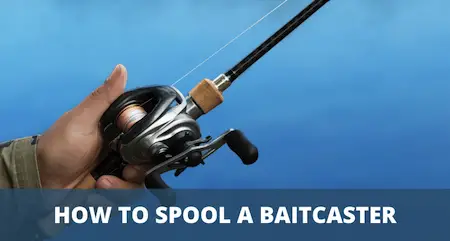Spooling A Baitcaster Made Easy – Step By Step Guide
UPDATED 08 MAY 2023
by Robert Ceran
If you’ve never done it before, spooling a baitcaster can seem a little daunting at first.
But once you know how to do it correctly, it’s really easy and you’ll be done in no time at all.

How to spool a baitcaster
Below is a summary of how to put line on a baitcaster in 7 steps:
- Attach baitcasting reel to your baitcasting rod
- Feed line through the first eye of the rod
- Feed line through the line guide of the baitcaster
- Tie line to spool of the baitcasting reel
- Trim off line end from the knot
- Start spooling line on to the reel by turning the handle
- Keep on filling the spool until there’s a 1/8th inch gap left at the edge of the spool
This process applies if you’re using monofilament or fluorocarbon to fill your baitcaster.
f you’re using braid instead, check our modified guide further down the page.
Before you start, it’s a good idea to familiarise yourself with the baitcaster parts, which are quite different from the parts of a spinning reel.
Here is each step in more detail:
1. Attach your baitcaster to a rod
Some people use a line spooler to put line on a baitcaster, but this isn’t really necessary, as you can achieve the same effect by using a rod instead.
2. Feed line through the first guide of the rod
This will help to run the line towards your baitcaster from the right direction, and help you to apply tension to it during the process.
3. Feed line through the line guide of the reel
This is essential, as the line guide moves from side to side while you spool, thus ensuring the line is filled evenly on to the spool.
4. Tie the line to the spool of your reel
If your baitcaster reel has holes in its spool, you can thread the line through two of the holes and then tie it down with a double overhand knot.
If the spool doesn’t have holes, wrap the line around the spool and tie it down with a double overhand knot.
5. Trim off the end of the line
This is important because you don’t want the end to stick out and get in the way of the main line during the spooling process.
6. Start spooling the baitcaster by turning the handle
Start spooling the baitcaster, and keep tension on the line while you do this. In order to avoid line twisting, make sure that the filler spool rotates in the same direction as the spool on your baitcasting reel.
7. Spool the baitcaster until it’s almost full
Don’t fill the baitcaster completely – leave a 1/8th inch gap between the edge of the spool and the line. This helps to prevent backlash.
How to spool a baitcaster by yourself
If you need to know how to line a baitcaster because you don’t have a buddy available to hold the filler spool for you, here’s what you need to do.
You can control the filler spool on your own by putting a pencil through the hole of the line spool, and stepping on one end of the pencil with one foot, while resting the other end of the pencil on top of your other foot.
That way the spool can rotate freely as you pull the line off it onto the reel.
In addition, run the line through your fingers before it reaches the reel, to apply tension consistently during the spooling process.
If you’re new to baitcasting reels, check out our article on what is the best baitcaster for beginners?
How to spool a baitcaster with braid
If you need to string a baitcaster with braid, this process is similar to the steps we outlined above, but instead of filling the baitcaster spool only with braided line, you’ll start by filling it with a monofilament backing.
How much backing do you need for a baitcaster?
Aim to fill 1/4th of your baitcaster spool with backing line. This line at the base of the spool almost never comes into use.
The reason for using backing is twofold: first of all, monofilament is a lot cheaper than braid, and secondly, braid slips too much when tied directly to the spool, while mono tends to stick firmly without slippage.
If you’re currently debating what gear ratio is best for your baitcasting reel, check out our article on what baitcaster gear ratio should you choose?
How do you spool a baitcaster backing?
In order to put backing on your baitcaster, start the spooling process with monofilament exactly as outlined above, until you’ve filled your baitcasting reel about 1/4th of the way.
Then cut the monofilament line, and tie it to the braid with an Albright knot.
Once the knot is tied firmly and cinched down, trim off the ends, and continue to string the baitcaster until it’s almost full, leaving a 1/8th inch gap.
Best line for baitcaster
Since we’ve shown you how to spool a baitcaster with 3 different types of lines, you might be wondering, “what’s the best line for baitcasting reels?”
There’s no simple answer to this question, as all 3 line types can perform well for baitcasting, depending on the exact application you’re planning to use.
If you’re a beginner, it’s best to start with monofilament, because it has less backlash tendency compared to fluorocarbon and braid (in addition to being cheaper).
Here are the main advantages and disadvantages of each type:
Braid: strongest line type with zero stretch. Ideal for setting the hook at a distance, and for cranking big fish away from cover before they can snag the line. But much higher visibility than the other two types.
Monofilament: Lower visibility than braid, and easier to cast with on a baitcaster since it generates less backlash. Floats on top of the water, which is great for topwater lures. But has high elasticity, which can be a problem for setting the hook.
Fluorocarbon: Sinks and is virtually invisible, which is handy in clear water. But a lot more expensive than mono, and tends to generate more backlash on a baitcasting reel.
Hopefully, these tips will help you to choose the best line for your purpose.
If you’re interested in finesse applications, then mono and fluoro are the best choice of line.
If you’re thinking about getting a new baitcasting reel, take a look at our review on the best baitcasters under $100.
Conclusion
This concludes our step by step guide on how to spool a baitcaster correctly, which is is the first step you need to get right in order to avoid baitcaster backlash.
If you’ve been following the baitcasting vs spinning reel debate, you may also want to know how to do this with a spinning reel, you can refer to our guide on how to spool a spinning reel.
You can also check out more content on fishing reels by going back to the main category page, or by looking at our article on different types of reels.
